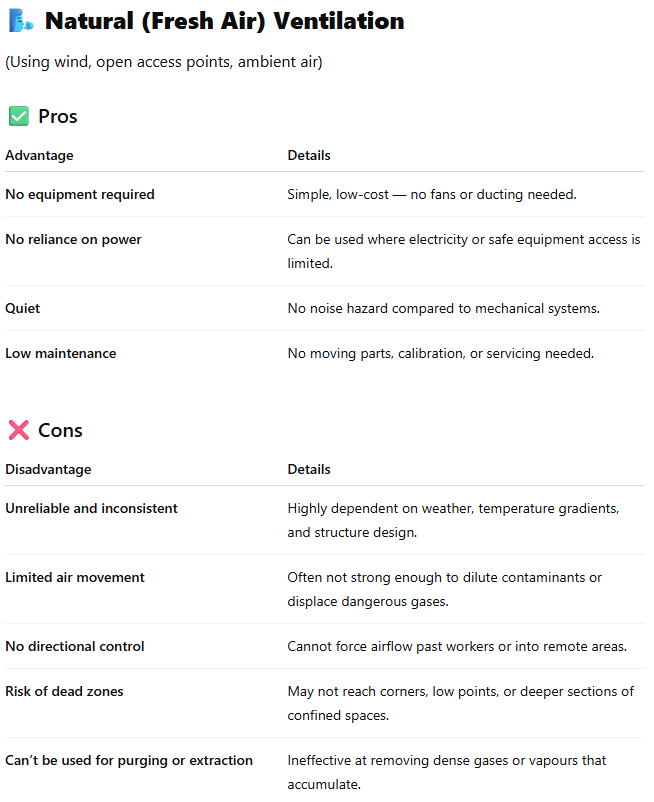The Role of Ventilation in Confined Space Safety
- Luke Dam
- Jul 9
- 6 min read

Confined spaces are among the most hazardous work environments in any industry. Whether it’s a storage tank, a sewer, a vessel, or a silo, the risks are real and often invisible. Many fatalities occur not just due to the primary hazard — but because of unseen, insidious factors like oxygen deficiency, toxic gases, and poor air circulation.
At the heart of mitigating these risks lies one critical and often underappreciated control: ventilation.
This article explores the why, what, and how of ventilation in confined spaces — from legal frameworks and practical methods to real-world case examples and common mistakes.
Why Ventilation Matters: The Key Risks
Ventilation in confined spaces isn’t just about “fresh air.” It’s a control measure that addresses a range of serious hazards:
1. Oxygen Deficiency or Enrichment
Normal air has ~20.9% oxygen.
Levels below 19.5% are considered oxygen-deficient and can cause confusion, unconsciousness, or death.
Above 23.5%, oxygen enrichment significantly increases fire and explosion risks.
Cause: Rusting metal (oxidation), fermentation, chemical reactions, or purging with inert gases (e.g. nitrogen).
2. Toxic Atmospheres
Hydrogen sulfide, carbon monoxide, solvents, cleaning agents, welding fumes — these can build up quickly.
Many are colourless, odourless, and accumulate in low-lying areas.
Exposure can lead to dizziness, unconsciousness, or even sudden death.
3. Flammable or Explosive Gases
Methane, vapours from fuels or solvents, and dusts can ignite with just a small spark.
A proper ventilation system can dilute these concentrations below their Lower Explosive Limits (LEL).
Regulatory Expectations
Across jurisdictions, ventilation is a non-negotiable aspect of confined space entry. In Australia, for example, the Model WHS Regulations (Reg 66–77) demand that:
Atmospheric testing is conducted before and during entry.
Controls are implemented to eliminate or minimise risks — including the use of ventilation to control airborne contaminants.
Internationally, OSHA, HSE (UK), and ISO standards (e.g. ISO 45001 and ISO 28600) all highlight ventilation as a critical control measure.
Types of Ventilation in Confined Spaces
Ventilation can be categorised broadly into:
1. Natural Ventilation
Air movement from wind, open hatches, etc.
Not reliable due to unpredictability.
Not recommended as a primary control in hazardous environments.
2. Mechanical Ventilation
Most commonly used and reliable method.
Includes:
Blowers/Fans: Push fresh air in (positive pressure) or pull contaminated air out (negative pressure).
Ducted Systems: Deliver air deep into confined spaces.
Local Exhaust Ventilation (LEV): Capture contaminants at the source.
Each method has pros and cons depending on the size, configuration, and contents of the space.



🟩 Best Practice
Use mechanical ventilation as the primary method in most confined space entries — especially when atmospheric hazards are present or could develop.
Natural ventilation may supplement mechanical systems (e.g., keeping hatches open to help airflow) but should not be relied on as a sole control in hazardous situations.
Key Ventilation Strategies
1. Pre-entry Purging
Used to remove toxic, flammable, or oxygen-displacing gases before entry begins. Often required after cleaning, welding, or chemical storage.
2. Continuous Ventilation
Keeps contaminants diluted during work operations. Especially important when:
Work generates fumes (e.g., welding, painting).
The atmosphere may change dynamically (e.g., biological activity in sewers).
Entry duration is prolonged.
3. Localised Extraction
Critical when workers are performing tasks that emit hazardous substances. LEV systems can capture emissions before they disperse.
4. Directional Airflow
Proper duct placement and fan configuration ensure air flows past the worker, not just into the space. Poor setup can trap contaminants or recirculate hazards.
Practical Considerations: Setting Up Effective Ventilation
To achieve safe and effective ventilation:
✅ Calculate Air Changes per Hour (ACH)
General recommendation: 6–12 ACH in confined spaces.
More may be needed based on risk assessment.
✅ Use Explosion-Proof Equipment
Fans and blowers should be intrinsically safe in explosive atmospheres.
✅ Ventilation Should Not Be Sole Reliance
Must be combined with atmospheric monitoring, standby rescue, entry permits, and training.
✅ Noise and Heat
Mechanical ventilation can introduce other hazards — noise, vibration, and heat stress must be considered.
✅ Ducting Matters
Rigid vs. flexible ducting, bends, and length all affect airflow.
Ducts should be kept short and as straight as possible.
Common Mistakes in Ventilation for Confined Spaces
Even experienced teams can overlook ventilation fundamentals. Here are some repeat offenders:
❌ Assuming one size fits all
Every confined space is different. A ventilation setup that works for one may fail in another.
❌ Venting without testing
You can't ventilate blind. Always pair with multi-gas monitoring (oxygen, CO, H₂S, LEL).
❌ Duct outlet placement
Placing ducts too far from the work area or allowing dead zones where contaminants collect.
❌ Not re-testing after ventilation loss
If ventilation stops (e.g., power outage), the atmosphere must be re-tested before re-entry.
❌ No backup or contingency plan
What happens if the fan fails? Is there a secondary system or evacuation plan?
The Human Factor: Training and Competency
Even the best-designed ventilation systems are only as good as the people implementing them.
✅ Workers must be trained to:
Recognise the signs of poor ventilation (e.g., odour, heat, symptoms).
Use and inspect fans, ducts, and blowers.
Understand the limits of natural ventilation.
Pair ventilation with atmospheric testing and confined space rescue plans.
Supervisors and safety officers should be capable of identifying when ventilation strategies are failing or insufficient.
Ventilation as Part of a Risk Control Hierarchy
Ventilation is an engineering control — but not the only control. It should be used in combination with:
Elimination or substitution (e.g., remove the need for entry)
Isolation (barriers, lockout)
Administrative controls (permits, procedures, time limits)
PPE (respirators — but only as a last resort)
Ventilation is often your best shot at preventing atmospheric harm before relying on PPE or rescue.
Final Thoughts: Breathing Room is Safety
Confined space fatalities are tragic, often avoidable, and frequently the result of inadequate atmospheric controls.
Ventilation isn’t just a compliance checkbox — it’s a lifeline.
Done right, it keeps workers breathing easy, focused, and safe. Done wrong, it can provide a false sense of security that ends in tragedy.
When planning your next confined space entry, ask:
Is our ventilation system matched to the risks?
Are we continuously ventilating — or just crossing our fingers?
Are we testing the right spots, at the right time, with the right tools?
Because when you’re working in a space that can kill silently, the air you breathe is everything.
SOURCES OF INFORMATION
🔹 1. Air Changes per Hour (ACH) in Confined Spaces
The recommendation of 6–12 ACH for confined spaces comes from several industry best practices, rather than a universally legislated figure. Specific references include:
ACGIH (American Conference of Governmental Industrial Hygienists) – Industrial Ventilation: A Manual of Recommended Practice
ACGIH recommends a minimum of 6 ACH for confined spaces, with higher rates (up to 12 or more) for high-risk operations like welding or when dealing with volatile contaminants.
OSHA (U.S. Occupational Safety and Health Administration) – Confined Space Guidelines
OSHA does not set a fixed ACH requirement but emphasizes that ventilation must be "adequate to maintain safe atmospheric conditions."
NIOSH (National Institute for Occupational Safety and Health) – Criteria for a Recommended Standard: Working in Confined Spaces
Recommends using ventilation systems capable of replacing air frequently enough to maintain atmospheric concentrations of contaminants below permissible exposure limits (PELs).
Australian Standard AS 2865 – Confined Spaces
Does not specify ACH numerically but requires that ventilation systems be capable of maintaining a safe atmosphere during occupancy and while performing tasks that could create atmospheric hazards.
HSE (UK Health and Safety Executive) – Confined Spaces: A brief guide to working safely (INDG258)
Recommends forced or mechanical ventilation for hazardous spaces but leaves the specific air turnover rate to risk assessment.
🔹 2. Oxygen Deficiency and Enrichment Thresholds
Safe Work Australia – Model WHS Regulations, Confined Space Code of Practice
Oxygen-deficient atmosphere = less than 19.5%Oxygen-enriched = more than 23.5%
OSHA 29 CFR 1910.146 –
Defines oxygen-deficient and oxygen-enriched atmospheres using the same thresholds.
🔹 3. Toxic and Flammable Gas Risks
NIOSH Pocket Guide to Chemical Hazards
Lists health risks and IDLH (Immediately Dangerous to Life or Health) values for gases like H₂S, CO, etc.
Australian WHS Code of Practice: Confined Spaces
Emphasizes the need to monitor flammable atmospheres and maintain below 5% LEL for safe entry.
🔹 4. Ventilation Strategies (Purging, Local Exhaust, etc.)
ACGIH and AS 2865
Discuss purging and local exhaust systems as engineering controls for managing confined space atmospheres.
NFPA 306 – Standard for the Control of Gas Hazards on Vessels
Includes methods and calculations for ventilation in marine and tank entry contexts.
Let's Talk Confined Space Safety
Have you experienced a ventilation near-miss or implemented an innovative solution? I’d love to hear your stories — comment below or connect to continue the conversation.




Comments